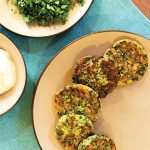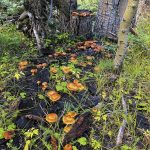
Evening primrose.
Winter is a slow season for most foragers, even in New Mexico—despite what many out-of-staters think, we get real winters here. I’m not complaining. In a good year, snow brings valuable moisture to our soil, and in early spring, snowmelt fills rivers and creeks to overflowing, bringing a bonanza of wild edible greens to riparian areas.
Holy Ghost Creek reaches the Pecos River at Terrero at an elevation of just over 7,700 feet, and snow melts slowly here. No matter how impatient I feel, I won’t set out until the back side of Baldy shows signs of melting. Then I pull on my hiking boots (the ground is wet and muddy this time of year!), stuff my backpack full of recycled plastic grocery bags, garden pruners, a bottle of water, and a few snacks, and hit the road.
I take NM 63 through Pecos Canyon and turn left onto Forest Road 122, then make a quick right into the parking lot of the Terrero Campground. Forest Road 122 closed to vehicles in winter, but it is accessible to pedestrians year-round. I walk up the road, crossing over a cattle grate and a small bridge that spans the creek. The banks are lined with junipers, ponderosa pines, Douglas firs, willows, wild plums, Gambel oaks, and aspens, but this early in the season there isn’t much deciduous foliage, which actually makes it easier to spot the fresh wild greens I’ve come for.
It’s just under three miles from the parking lot to Holy Ghost Campground, where the road ends. I don’t always walk the six-mile round trip; there’s plenty to harvest within an hour’s walk of the parking area.
Dandelions (Taraxacum species) are everywhere! And while many lawn enthusiasts love to hate this useful plant, foragers do not. Dandelions are a great wild green for beginning foragers since almost everyone recognizes the plant. In addition to the greens, you can also eat the flowers and roots, making the dandelion an edible superstar in my book.
Along the creek, growing conditions are cool and moist, producing the most tender and tasty dandelion greens. Later in the season, plants growing in the sun may become bitter and slightly tough, both of which can be resolved by blanching and cooking. But early spring dandelions can be enjoyed raw in a salad as well as cooked in stir-fries, eggs, and basically any other dish in which you’d use a bitter green like arugula or radicchio. They also make a great pesto.
Less familiar than the dandelion but almost equally ubiquitous is curly dock (Rumex crispus), sometimes called yellow dock because of the color of its root, which has several medicinal uses. But I’m all about the food, and curly dock is one of my favorite early spring greens. It easily tolerates a few frosts and even some light snow, which means it’s often the first (and last) edible wild green of the season.
The youngest leaves, still tightly furled at the center of each plant, are my favorites, but fully unfurled leaves are also tart and tasty. Dock is highly mucilaginous, which makes it more enjoyable to eat cooked rather than raw. It’s delish in egg dishes, soups, stews, and stir-fries. Bonus: Dock produces another round of new growth in fall.
Keep your eyes on the water’s edge, because that’s where you’ll find winter cress (Barbarea vulgaris). I’m not going to lie, winter cress is a bitter green, but don’t let that keep you from trying it. Lots of popular greens qualify as bitter (broccoli rabe, endive, and escarole, to name a few), and when combined with mild greens, they make a balanced dish. Both the young leaves and the unopened flower buds of winter cress are edible.
This isn’t a plant I recommend eating raw; blanching takes the bitterness down a few notches, so the flavor is nicely sharp. Leave the lid off the pot so that bitter compounds can escape with the steam. Cooking winter cress with robust foods like chiles, strong cheese, cured meat, or vinegar also helps balance the flavor. Winter cress grows best in moist soil; I find it regularly on the banks of Holy Ghost Creek.
If you’ve hiked the Sangres in summer, you may have noticed sochan (Rudbeckia laciniata) blooming streamside and mistaken it for its cousin the black-eyed Susan. The flowers of both plants look similar at a glance, but sochan has a green center rather than a black eye. This is another plant that appreciates moist soil, although it tolerates some drought.
Sochan produces two rounds of tasty greens, once in spring and again in fall. The young leaves of spring have an almost nutty flavor, while the fall leaves remind me of a mild bok choy. Young leaves can be eaten raw in salads or sandwiches, while older leaves are better cooked. Harvest foliage either before the plant blooms or in fall, when the plant has finished blooming and puts out a second round of basal leaves.

Cow parsnip (Heracleum maximum) is a member of the carrot family, and as every forager knows, you have to be careful with the carrot family. It includes some delicious plants, like carrots and caraway, and some toxic plants, like poison hemlock and water dropwort. Cow parsnip is one of the good guys. It grows best in moist soils (thank you, Holy Ghost Creek), has large, palmate leaves, and can grow to be five to six feet tall. It produces large, flat umbels of tiny white flowers in summer, but the foliage is most delicious in early spring, when the leaves are small and before the plant blooms.
Cow parsnip leaves are hairy, so this green is better cooked. The flavor is unique, neither mild nor bitter. It’s difficult to describe a new flavor in terms of familiar ones; the best I can do is tell you that cow parsnip reminds me of a slightly spicy celery. Trust me when I say that doesn’t do this plant justice. You’ll just have to try it for yourself.
When the sap of cow parsnip interacts with sunlight, it can cause a skin rash, so wear gloves when harvesting or harvest in shade. Do not freak out about this! The common garden parsnip causes the same kind of phytophotodermatitis. If you don’t get the sap on your skin in direct sun, you’ll be fine.
Farther back from the creek, you’ll find common mallow (Malva neglecta), a mild green with a slightly hairy leaf. You can eat it raw, but I don’t love the texture. Also, like most members of the genus Malva, common mallow is mucilaginous, which makes it useful as a thickener in soups and stews but not so much fun to eat raw. Cooking dissolves the hairs and mucilage, and makes the leaves more palatable.
Common mallow is drought tolerant and grows in sun or shade, but plants growing in shade with moist soil are generally more tender and have larger leaves. It has a prostrate growth habit, producing leaves on long, creeping stems. Many Middle Eastern cuisines combine mallow with garlic, lemon juice, and olive oil. Its mild flavor makes it a useful companion to more bitter greens like dandelion and winter cress.
Evening primrose (Oenothera biennis) grows in the same habitat as mallow. It, too, has edible greens, but for today’s wild food adventure we’re going to use its roots. This is a biennial plant, and its roots are best harvested at the end of its first year, or in early spring of its second year, before the plant starts putting out new growth. Once new growth starts, the plant draws on the roots’ stored nutrition, leaving less behind for us to enjoy.
The first-year growth of evening primrose forms a basal rosette of lanceolate leaves with wavy or toothed leaf margins. Look for the dried stalks of last year’s seeds to find a patch of young plants. The roots have a hint of black pepper flavor. Some people report throat irritation after eating the raw root, so let’s not do that! After peeling them, you can cook sliced roots in soups and stews, or boil and mash them for a side dish or fritters.
After a long, cold winter, I look forward to both my first woodland walk of the season and the first harvest of spring. Finding an edible plant in the wild feels like winning Mother Nature’s scavenger hunt, even to the most experienced forager. I can’t wait to taste the unbuyable flavors of these wild greens, and as I walk back to the car, I consider how to do them justice. Could I cook them all up in a simple stir-fry? Sure, but I’d rather celebrate the harvest with something a little more indulgent and delicious. And so I give you Spring Greens Fritters.
Key Identification Characteristics

Curly Dock
- Leaves attach to the plant with a mucilaginous sheath at the base of each leaf. If your hands aren’t covered with goo when you’re harvesting dock, then you’re not harvesting dock.
- Leaves form a rosette and can be one to three feet tall.
- Tall stems (four to six feet) of brown seeds persist through winter, making this plant easy to spot from a distance.


Ellen Zachos shares a recipe for “Spring Greens Fritters” that you can adapt to whatever greens you have on hand.
Dandelion
-
Leaves form a basal rosette of foliage.
-
Leaves are toothed, and the teeth point toward the center of the plant.
-
Plants produce one flower per stem and the flower stems do not branch.


Cow parsnip
-
Stems and leaves are hairy.
-
Leaves have three pointy lobes and toothed margins.
-
Stems are solid green; they never have red or purple blotches like some toxic members of the carrot family.


Sochan
- Spring growth forms a basal rosette of leaves, each with three deeply divided lobes.
- Drooping yellow petals surround a yellow-green center.
- Flower stems have alternate leaves that get progressively smaller the farther up they go.


Common Mallow
- Leaves are rounded with scalloped or toothed margins.
- Leaves and stems are hairy.
- Flowers have five petals and are white, pale pink, or pale purple; flowers are followed by fruits that resemble wheels of cheese.


Ellen Zachos shares a recipe for “Spring Greens Fritters” that you can adapt to whatever greens you have on hand.
Winter Cress
- Foliage is lobed, with the terminal lobe larger than the rest.
- Leaves form a basal rosette.
- Yellow four-petaled flowers grow on stems that can be two to three feet tall. This is a good ID characteristic, but be sure to harvest before the flowers open. By then, the leaves are far too bitter to be tasty.



Evening Primrose
- Plentiful, bright yellow, four-petaled flowers bloom in summer; they open in the evening, hence its common name.
- Leaves have a prominent white or reddish midrib.
- First-year foliage forms a basal rosette and indicates the best time to harvest the root.

Note: The Santa Fe National Forest (which includes Holy Ghost Creek) does not have published rules for foragers, except to allow the collection of up to one bushel of piñon nuts for personal use. A phone call to the superintendent’s office confirmed that reasonable foraging for personal consumption is allowed on forest land.

Ellen Zachos
Ellen Zachos lives in Santa Fe and is the author of eight books, including the recently released The Forager's Pantry. She is the co-host of the Plantrama podcast (plantrama.com), and writes about wild foods at backyardforager.com. Zachos offers several online foraging courses at backyard-forager.thinkific.com.
















